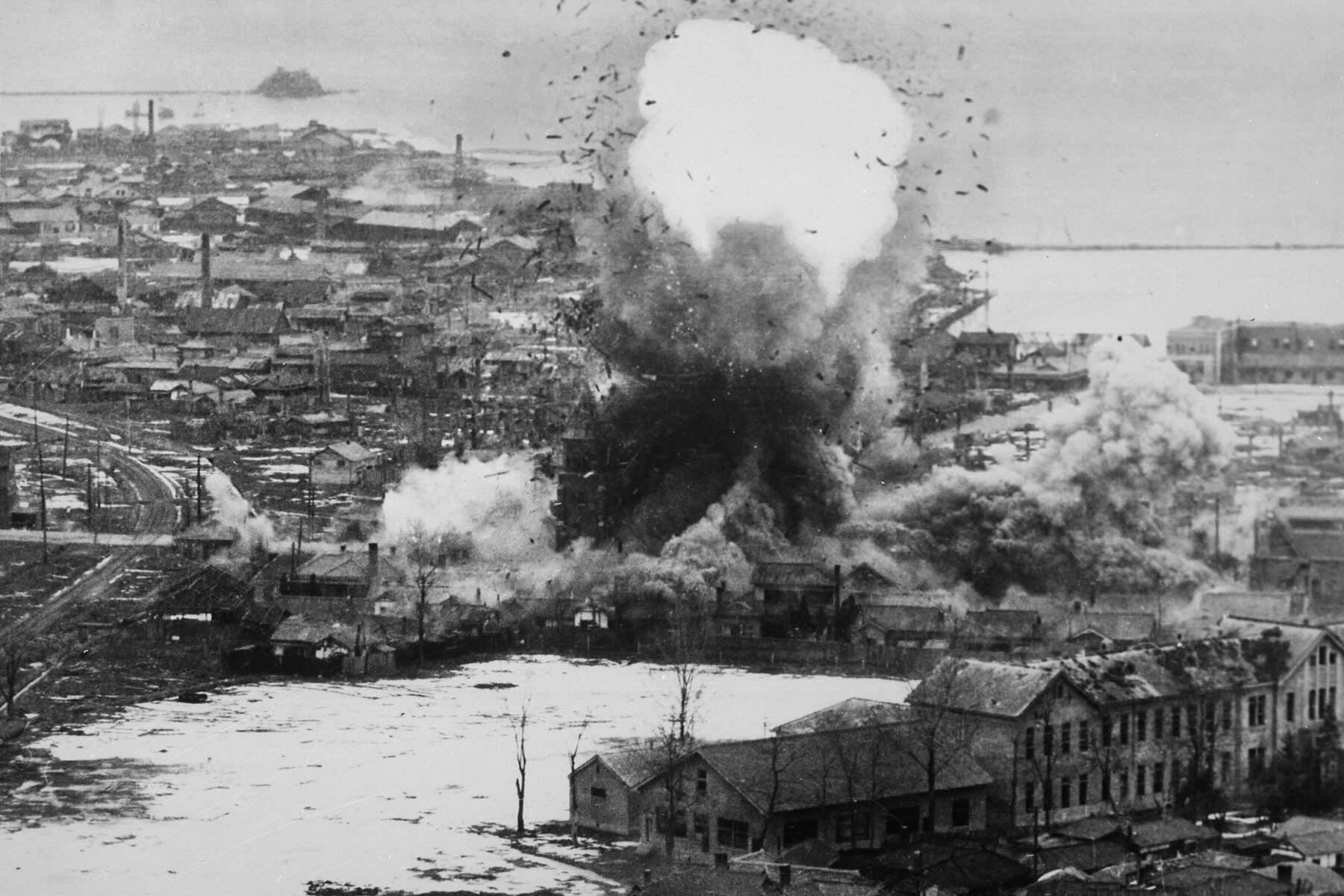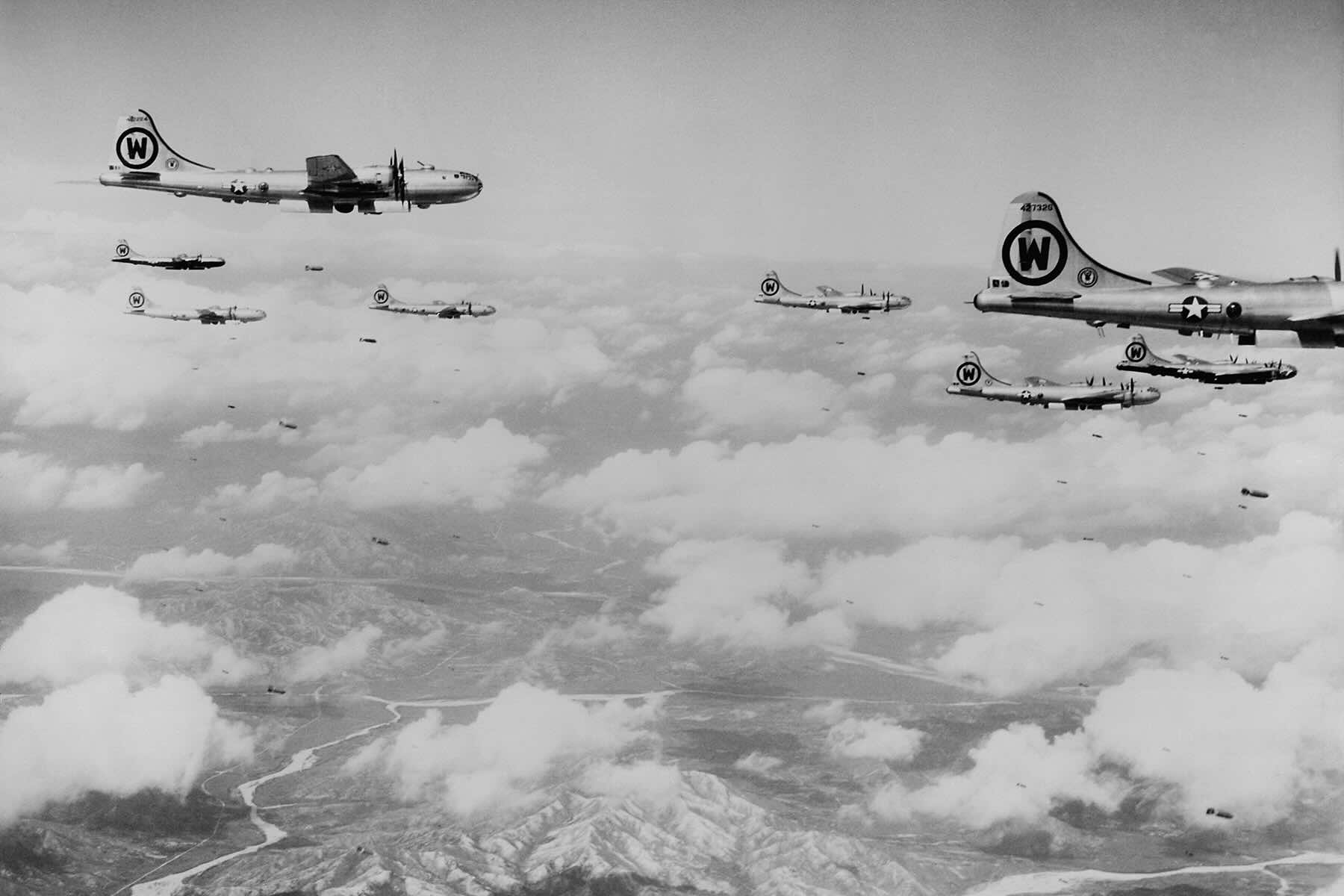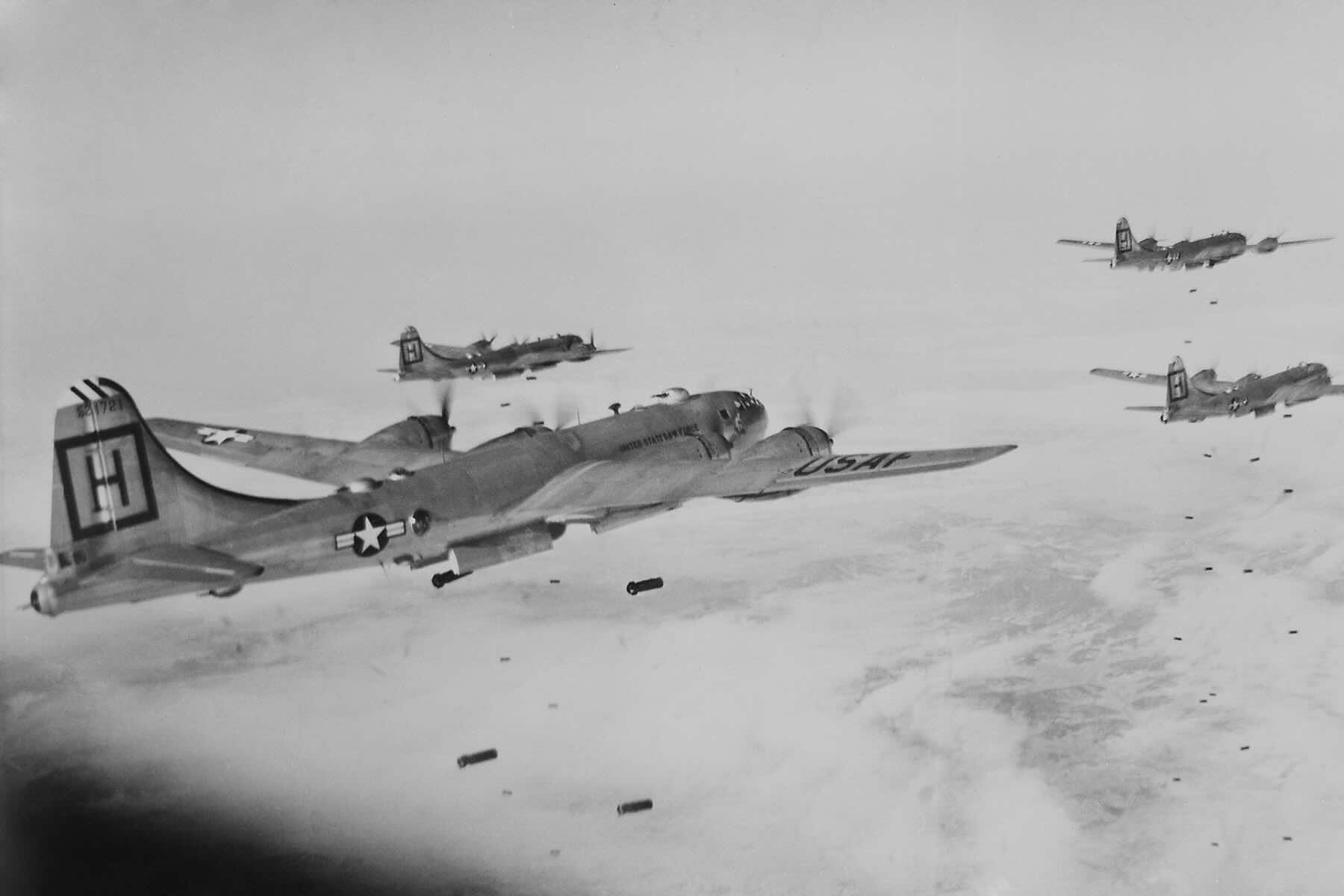
Often overshadowed by World War II and the Vietnam War, the Korean War almost escalated into a nuclear conflict, marking a perilous moment in Cold War history.
The clash began on June 25, 1950, with North Korea’s invasion of South Korea. It quickly drew in major world powers, setting the stage for a potentially catastrophic escalation.
Supported by Soviet T-34 tanks, 75,000 North Korean troops launched a surprise attack at dawn. The South Korean military, unprepared and underequipped, quickly crumbled under the assault. Within days, North Korean forces captured the South Korean capital of Seoul, pushing the South Korean army into a desperate retreat.
Across the Pacific, the United States, alarmed by the rapid advance of Communist forces, decided to intervene. The U.S. viewed the invasion as a critical test of containment policy against the spread of Communism in Asia.
Over the next three years, U.S. and United Nations (UN) forces would engage in fierce battles with North Korean and Chinese troops, transforming the Korean Peninsula into a major Cold War battleground.
In the early months of the Korean War, there were significant shifts in momentum. Initial North Korean successes were countered by a bold amphibious landing at Incheon by UN forces, led by General Douglas MacArthur. The operation turned the tide, allowing UN forces to recapture Seoul and push into North Korea.
As UN forces advanced towards the Chinese border, the stakes grew higher. China feared an invasion on its own soil and sent a massive contingent of troops to support North Korea. Their intervention pushed UN forces back, resulting in a brutal stalemate along the 38th parallel. It was during that volatile period that the prospect of nuclear warfare emerged.
General MacArthur, frustrated by the stalemate and heavy losses, proposed a drastic measure – the use of nuclear weapons against Chinese and North Korean forces. He suggested bombing strategic positions and supply lines to halt the communist advance and force a swift end to the conflict. The plan included the potential use of atomic bombs, a notion that alarmed both U.S. military and political leaders.
The Korean War’s potential to escalate into a nuclear conflict hinged on several strategic decisions, diplomatic maneuvers, and political calculations. Leaders weighed the catastrophic consequences of nuclear war against the immediate military advantages.
President Harry S. Truman faced an excruciating decision. On one hand, using nuclear weapons could potentially bring a decisive end to the war. On the other hand, it risked triggering a broader conflict with the Soviet Union and China, both of whom possessed significant military capabilities.
Truman was acutely aware of the devastating power of nuclear weapons, having authorized their use against Japan just five years earlier. One key factor was the international community’s response.
The United Nations’ involvement, particularly the rapid assembly and deployment of forces, demonstrated a collective effort to contain the conflict. The multilateral approach was instrumental in preventing unilateral actions that could have escalated tensions further.
The U.S. military leadership also grappled with the limitations of conventional warfare. The Korean terrain, characterized by rugged mountains and harsh weather conditions, posed significant challenges for ground operations.
The logistical difficulties in maintaining supply lines and supporting front-line troops added to the complexity of the conflict. Those factors contributed to the consideration of more drastic measures, such as the use of nuclear weapons, to achieve a decisive victory.
The presence of nuclear-capable B-29 bombers in the region underscored the seriousness of the situation. In July 1950, Truman ordered the deployment of the bombers to the United Kingdom and Guam, signaling to the Soviet Union and China the possibility of nuclear escalation. However, the armed bombers did not carry the critical nuclear cores, serving more as a strategic bluff than an immediate threat.
The debate over the use of nuclear weapons reached a peak in late 1950. In November, during a press conference, Truman hinted at the possibility of using nuclear weapons, stating that all options were on the table to secure victory.
MacArthur’s public statements advocating for nuclear strikes created tension with the Truman administration. The general’s insubordination and persistent calls for aggressive action led to his dismissal in April 1951. Truman replaced him with General Matthew Ridgway, who pursued a more conventional approach to the war.
Despite the tensions, cooler heads prevailed. The UN forces, using conventional means, managed to halt the Chinese advance and stabilize the front lines. Intensive bombing campaigns and strategic ground operations eventually perpetuated the stalemate.
The war settled into a grueling pattern of trench warfare, reminiscent of World War I, with neither side able to secure a decisive victory. By mid-1951, both sides recognized the futility of further fighting without significant concessions.
Armistice talks began, dragging on for two years before an agreement was reached on July 27, 1953. The armistice established the Korean Demilitarized Zone (DMZ), a heavily fortified border that remains one of the most tense and militarized areas in the world.
Estimates suggest that approximately 2.5 million people died, including soldiers and civilians from both sides. The war also caused widespread devastation across the Korean Peninsula, leaving cities in ruins and millions of people displaced.
The use of conventional bombing, particularly by B-29 bombers, inflicted significant damage on North Korean infrastructure, further exacerbating the humanitarian crisis.
The legacy of the Korean War extended beyond the immediate aftermath. The conflict solidified the division of Korea into two separate states, a division that persists to this day. The armistice, while halting active combat, did not result in a formal peace treaty, leaving the peninsula in a state of suspended conflict.
The continued military presence along the DMZ and periodic skirmishes underscore the lasting tension and the unresolved nature of the war. The decision not to use nuclear weapons in Korea also set a precedent for the Cold War, demonstrating the potential for restraint even in the face of severe military setbacks.
The Korean War’s near-nuclear escalation also influenced future U.S. military planning and foreign policy, emphasizing the need for careful consideration before employing massively devastating weapons.
MI Staff (Korea)
Everett Collection (via Shutterstock) and Morning Calm Weekly Newspaper Photo Archive / CC BY-NC-ND 2.0
- Exploring Korea: Stories from Milwaukee to the DMZ and across a divided peninsula
- A pawn of history: How the Great Power struggle to control Korea set the stage for its civil war
- Names for Korea: The evolution of English words used for its identity from Gojoseon to Daehan Minguk
- SeonJoo So Oh: Living her dream of creating a "folded paper" bridge between Milwaukee and Korean culture
- A Cultural Bridge: Why Milwaukee needs to invest in a Museum that celebrates Korean art and history
- Korean diplomat joins Milwaukee's Korean American community in celebration of 79th Liberation Day
- John T. Chisholm: Standing guard along the volatile Korean DMZ at the end of the Cold War
- Most Dangerous Game: The golf course where U.S. soldiers play surrounded by North Korean snipers
- Triumph and Tragedy: How the 1988 Seoul Olympics became a battleground for Cold War politics
- Dan Odya: The challenges of serving at the Korean Demilitarized Zone during the Vietnam War
- The Korean Demilitarized Zone: A border between peace and war that also cuts across hearts and history
- The Korean DMZ Conflict: A forgotten "Second Chapter" of America's "Forgotten War"
- Dick Cavalco: A life shaped by service but also silence for 65 years about the Korean War
- Overshadowed by conflict: Why the Korean War still struggles for recognition and remembrance
- Wisconsin's Korean War Memorial stands as a timeless tribute to a generation of "forgotten" veterans
- Glenn Dohrmann: The extraordinary journey from an orphaned farm boy to a highly decorated hero
- The fight for Hill 266: Glenn Dohrmann recalls one of the Korean War's most fierce battles
- Frozen in time: Rare photos from a side of the Korean War that most families in Milwaukee never saw
- Jessica Boling: The emotional journey from an American adoption to reclaiming her Korean identity
- A deportation story: When South Korea was forced to confront its adoption industry's history of abuse
- South Korea faces severe population decline amid growing burdens on marriage and parenthood
- Emma Daisy Gertel: Why finding comfort with the "in-between space" as a Korean adoptee is a superpower
- The Soul of Seoul: A photographic look at the dynamic streets and urban layers of a megacity
- The Creation of Hangul: A linguistic masterpiece designed by King Sejong to increase Korean literacy
- Rick Wood: Veteran Milwaukee photojournalist reflects on his rare trip to reclusive North Korea
- Dynastic Rule: Personality cult of Kim Jong Un expands as North Koreans wear his pins to show total loyalty
- South Korea formalizes nuclear deterrent strategy with U.S. as North Korea aims to boost atomic arsenal
- Tea with Jin: A rare conversation with a North Korean defector living a happier life in Seoul
- Journalism and Statecraft: Why it is complicated for foreign press to interview a North Korean defector
- Inside North Korea’s Isolation: A decade of images show rare views of life around Pyongyang
- Karyn Althoff Roelke: How Honor Flights remind Korean War veterans that they are not forgotten
- Letters from North Korea: How Milwaukee County Historical Society preserves stories from war veterans
- A Cold War Secret: Graves discovered of Russian pilots who flew MiG jets for North Korea during Korean War
- Heechang Kang: How a Korean American pastor balances tradition and integration at church
- Faith and Heritage: A Pew Research Center's perspective on Korean American Christians in Milwaukee
- Landmark legal verdict by South Korea's top court opens the door to some rights for same-sex couples
- Kenny Yoo: How the adversities of dyslexia and the war in Afghanistan fueled his success as a photojournalist
- Walking between two worlds: The complex dynamics of code-switching among Korean Americans
- A look back at Kamala Harris in South Korea as U.S. looks ahead to more provocations by North Korea
- Jason S. Yi: Feeling at peace with the duality of being both an American and a Korean in Milwaukee
- The Zainichi experience: Second season of “Pachinko” examines the hardships of ethnic Koreans in Japan
- Shadows of History: South Korea's lingering struggle for justice over "Comfort Women"
- Christopher Michael Doll: An unexpected life in South Korea and its cross-cultural intersections
- Korea in 1895: How UW-Milwaukee's AGSL protects the historic treasures of Kim Jeong-ho and George C. Foulk
- "Ink. Brush. Paper." Exhibit: Korean Sumukhwa art highlights women’s empowerment in Milwaukee
- Christopher Wing: The cultural bonds between Milwaukee and Changwon built by brewing beer
- Halloween Crowd Crush: A solemn remembrance of the Itaewon tragedy after two years of mourning
- Forgotten Victims: How panic and paranoia led to a massacre of refugees at the No Gun Ri Bridge
- Kyoung Ae Cho: How embracing Korean heritage and uniting cultures started with her own name
- Complexities of Identity: When being from North Korea does not mean being North Korean
- A fragile peace: Tensions simmer at DMZ as North Korean soldiers cross into the South multiple times
- Byung-Il Choi: A lifelong dedication to medicine began with the kindness of U.S. soldiers to a child of war
- Restoring Harmony: South Korea's long search to reclaim its identity from Japanese occupation
- Sado gold mine gains UNESCO status after Tokyo pledges to exhibit WWII trauma of Korean laborers
- The Heartbeat of K-Pop: How Tina Melk's passion for Korean music inspired a utopia for others to share
- K-pop Revolution: The Korean cultural phenomenon that captivated a growing audience in Milwaukee
- Artifacts from BTS and LE SSERAFIM featured at Grammy Museum exhibit put K-pop fashion in the spotlight
- Hyunjoo Han: The unconventional path from a Korean village to Milwaukee’s multicultural landscape
- The Battle of Restraint: How nuclear weapons almost redefined warfare on the Korean peninsula
- Rejection of peace: Why North Korea's increasing hostility to the South was inevitable
- WonWoo Chung: Navigating life, faith, and identity between cultures in Milwaukee and Seoul
- Korean Landmarks: A visual tour of heritage sites from the Silla and Joseon Dynasties
- South Korea’s Digital Nomad Visa offers a global gateway for Milwaukee’s young professionals
- Forgotten Gando: Why the autonomous Korean territory within China remains a footnote in history
- A game of maps: How China prepared to steal Korean history to prevent reunification
- From Taiwan to Korea: When Mao Zedong shifted China’s priority amid Soviet and American pressures
- Hoyoon Min: Putting his future on hold in Milwaukee to serve in his homeland's military
- A long journey home: Robert P. Raess laid to rest in Wisconsin after being MIA in Korean War for 70 years
- Existential threats: A cost of living in Seoul comes with being in range of North Korea's artillery
- Jinseon Kim: A Seoulite's creative adventure recording the city’s legacy and allure through art
- A subway journey: Exploring Euljiro in illustrations and by foot on Line 2 with artist Jinseon Kim
- Seoul Searching: Revisiting the first film to explore the experiences of Korean adoptees and diaspora



















